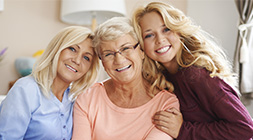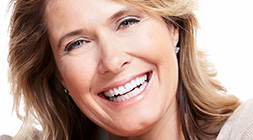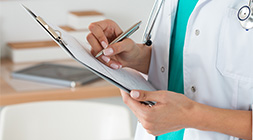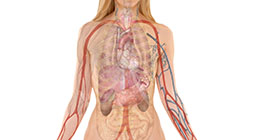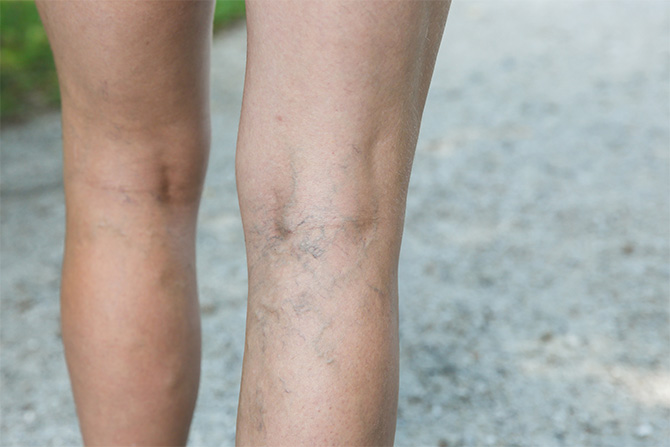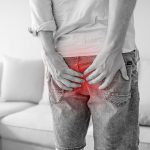Overview
Symptoms
Causes
Prescription
Health Tips
One of the most common vein conditions, about 20 to 25 percent of the adult population and 50 percent of people over the age of 50 have some type of varicose vein (hemorrhoids are a form of varicose vein). The inner walls of veins contain small one-way valves that ensure proper one-way circulation by preventing backward blood flow. Varicose veins occur when these valves fail to function properly causing blood to pool in the veins. The excess fluid leads to disfigurement of the vein, which will stretch, bulge, become blue and lumpy in appearance.
While unsightly, small varicose veins do not typically cause harm when they are near the surface of the skin. Complications such as ulcerations, deep-vein blood clots or bleeding under the skin may occur in larger varicose veins that are deeper in the leg. While rare, serious cases can result in inflammation of the veins (phlebitis), clots that can relocate in the lungs (pulmonary embolism) and leg ulcerations, all of which require immediate medical attention. Varicose veins can also be related to more serious vein disorders so they require a careful evaluation prior to treatment.
Symptoms
Symptoms may include:
- Leg cramps, pain, aching and swelling
- Tight, heavy or restless legs
- Twisted and bulging veins
- Veins may itch, and sores may develop
More serious symptoms, that require medical attention include:
- Itchy skin over the vein
- Inflammation of the skin around the ankle
- Rashes or sores on the skin
- Skin ulcers
- Vein hardening
Causes
Veins are fragile and pressure caused by being overweight, smoking, pregnancy and occupational environment (too much standing, sitting or heavy lifting) causes the veins to dilate, leading to damage of the valves. In fact, 10 times the normal pressure is forced on the veins if standing for many hours. Other factors include whether one has heart or liver disease, constipation, age, hormone imbalances and changes, tumors in the abdomen, vitamin C deficiency, takes birth control pills, or hormone replacement therapy, or has a genetic predisposition for varicose veins.
Prescription for Health
Ultrasound has revolutionized the treatment of varicose veins. The proper method to treat varicose veins in the twenty-first century is to perform an ultrasonic map of all the veins in the lower limbs. This takes about 40 minutes and is completely painless and non-invasive. Following the mapping procedure, the doctor can see the precise location of the failed venous valves. All varicose vein disease is due to failed venous valves. The valves are present to prevent blood from falling down to the toes. The venous blood is supposed to move against gravity back to the heart, but if the valves have failed the blood falls and the vein starts to dilate. Using an ultrasound, a phlebologist can inject foam into a vein causing it to collapse permanently.
Surgically stripping veins is no longer necessary. Surgically stripping veins is not recommended because it results in unsightly scars and can lead to further vein growth. A laser can also be used with excellent results. With proper follow up, successful resolution of vein disease exceeds 90 percent. One can find a vein specialist through the American Board of Phlebology which has online search available.
| Nutrient | Dosage | Action |
|---|---|---|
| Multivitamin with minerals (contains no iron) |
As directed | Supports immune function; potent antioxidant; supports vein integrity; detoxifies liver; prevents deficiency; repairs blood vessel walls; prevents blood clotting and bruising; improves circulation |
| Horse chestnut seed* extract |
500 mg | Supports vein health and reduces varicose veins; eliminates hemorrhoids; eliminates heavy-feeling legs and swelling of legs.
Reduces blood pooling in the lower leg. |
| Diosmin (micronized)* | 900 mg | Improves vein tone, increases lymphatic drainage, inhibits inflammation, strengthens capillaries, promotes healing of varicose ulcers. Significantly reduces leg and ankle swelling, improves ulcer healing. |
| Butcher’s broom extract* | 100 mg | Acts on lymphatic drainage, the constriction of blood vessels and microcirculation. Improves venous function and reduces symptoms of venous insufficiency. |
| Hesperidin* | 100 mg | Reduces the permeability of capillaries and is anti-inflammatory |
| Choline-stabilized orthosilicic acid | 10 drops in juice daily or 2 capsules | Choline-stabilized orthosilicic acid was found to enhance vein health |
| Bromelain | 500–1000 mg after every meal | Anti-inflammatory, shown to prevent hard, lumpy skin around bulging varicose veins |
| Proanthocyanidins from blueberries, cranberries, mangosteen, pomegranate | 500 mg daily | Improves the integrity of capillaries and veins; protects collagen from damage in varicose veins
Potent antioxidant effect |
| Pycnogenol French maritime pine bark | 150 mg daily | Heals venous ulcer and reduces edema |
*Can be found in one formula
Health Tips to Enhance Healing
- Apply witch hazel ointment topically twice a day to reduce swelling and tone veins.
- Avoid standing or sitting for long periods.
- Consume foods high in fiber.
- Do not scratch veins when itchy as this may cause further damage.
- Drink plenty of pure, filtered water every day.
- Water maintains a healthy level of blood volume and prevents constipation.
- During long periods of sitting while traveling, get up and move around every once in awhile to keep circulation going and prevent blood clots from forming in the veins.
- Wear loose fitting clothing and drink plenty of water.
- Reduce weight; even 10 extra pounds puts added pressure on the venous system.
- Regular exercise is mandatory for circulation disorders and maintaining weight.
- Shift weight and stand on toes periodically if standing for long periods of time.
- While sitting at a desk wiggle toes and flex leg muscles to keep blood flowing.
- Do not cross legs and avoid putting pressure on the legs.
- Sit or lie down and raise the legs above the heart for 20 minutes every day.
- Stop smoking; nicotine constricts blood vessels.
- Supportive elastic stockings specifically for varicose veins in combination with the above recommendations can dramatically reduce the appearance of unsightly varicose veins. Stockings should be properly measured and fitted.


